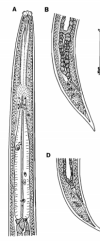.
Eudorylaimus diadematus female
Drawing from De Bruin and Heyns, 1992
|
Female:
The species is characterized by a disc-shaped structure between the
base of the esophagus and the cardia, bulging out into the body cavity
on the dorsal side (De Bruin and Heyns, 1992).
|